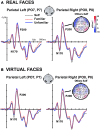The Neurological Traces of Look-Alike Avatars
- PMID: 27536228
- PMCID: PMC4971066
- DOI: 10.3389/fnhum.2016.00392
The Neurological Traces of Look-Alike Avatars
Abstract
We designed an observational study where participants (n = 17) were exposed to pictures and look-alike avatars pictures of themselves, a familiar friend or an unfamiliar person. By measuring participants' brain activity with electroencephalography (EEG), we found face-recognition event related potentials (ERPs) in the visual cortex, around 200-250 ms, to be prominent for the different familiarity levels. A less positive component was found for self-recognized pictures (P200) than pictures of others, showing similar effects in both real faces and look-alike avatars. A rapid adaptation in the same component was found when comparing the neural processing of avatar faces vs. real faces, as if avatars in general were assimilated as real face representations over time. ERP results also showed that in the case of the self-avatar, the P200 component correlated with more complex conscious encodings of self-representation, i.e., the difference in voltage in the P200 between the self-avatar and the self-picture was reduced in participants that felt the avatar looked like them. This study is put into context within the literature of self-recognition and face recognition in the visual cortex. Additionally, the implications of these results on look-alike avatars are discussed both for future virtual reality (VR) and neuroscience studies.
Keywords: avatars; event related potentials; face-recognition; memory; self-recognition; visual cortex.
Figures






Similar articles
-
The contribution of body perception to self-identity: an event-related potential study.Soc Cogn Affect Neurosci. 2025 Mar 10;20(1):nsaf020. doi: 10.1093/scan/nsaf020. Soc Cogn Affect Neurosci. 2025. PMID: 40036617 Free PMC article.
-
The Effects of Dynamic and Static Emotional Facial Expressions of Humans and Their Avatars on the EEG: An ERP and ERD/ERS Study.Front Neurosci. 2021 Apr 22;15:651044. doi: 10.3389/fnins.2021.651044. eCollection 2021. Front Neurosci. 2021. PMID: 33967681 Free PMC article.
-
Evaluating the Feasibility of Emotion Expressions in Avatars Created From Real Person Photos: Pilot Web-Based Survey of Virtual Reality Software.JMIR Form Res. 2023 May 11;7:e44632. doi: 10.2196/44632. JMIR Form Res. 2023. PMID: 37166970 Free PMC article.
-
The neural dynamics of familiar face recognition.Neurosci Biobehav Rev. 2024 Dec;167:105943. doi: 10.1016/j.neubiorev.2024.105943. Epub 2024 Nov 16. Neurosci Biobehav Rev. 2024. PMID: 39557351 Review.
-
Repetition effects in human ERPs to faces.Cortex. 2016 Jul;80:141-53. doi: 10.1016/j.cortex.2015.11.001. Epub 2015 Nov 18. Cortex. 2016. PMID: 26672902 Review.
Cited by
-
Malleability of the self: electrophysiological correlates of the enfacement illusion.Sci Rep. 2019 Feb 8;9(1):1682. doi: 10.1038/s41598-018-38213-y. Sci Rep. 2019. PMID: 30737445 Free PMC article.
-
From Robot to Virtual Doppelganger: Impact of Visual Fidelity of Avatars Controlled in Third-Person Perspective on Embodiment and Behavior in Immersive Virtual Environments.Front Robot AI. 2019 Feb 18;6:8. doi: 10.3389/frobt.2019.00008. eCollection 2019. Front Robot AI. 2019. PMID: 33501025 Free PMC article.
-
The contribution of body perception to self-identity: an event-related potential study.Soc Cogn Affect Neurosci. 2025 Mar 10;20(1):nsaf020. doi: 10.1093/scan/nsaf020. Soc Cogn Affect Neurosci. 2025. PMID: 40036617 Free PMC article.
-
Eyewitness Memory in Face-to-Face and Immersive Avatar-to-Avatar Contexts.Front Psychol. 2018 Apr 17;9:507. doi: 10.3389/fpsyg.2018.00507. eCollection 2018. Front Psychol. 2018. PMID: 29719520 Free PMC article.
-
The promise of the metaverse in mental health: the new era of MEDverse.Heliyon. 2022 Nov 23;8(11):e11762. doi: 10.1016/j.heliyon.2022.e11762. eCollection 2022 Nov. Heliyon. 2022. PMID: 36458297 Free PMC article. Review.
References
-
- Aymerich-Franch L., Karutz C., Bailenson J. N. (2012). “Effects of facial and voice similarity on presence in a public speaking virtual environment,” in Proceeding of the International Society for Presence Reseach Annual Conference (Philadepelphia, PA: ), 24–26.
Grants and funding
LinkOut - more resources
Full Text Sources
Other Literature Sources

